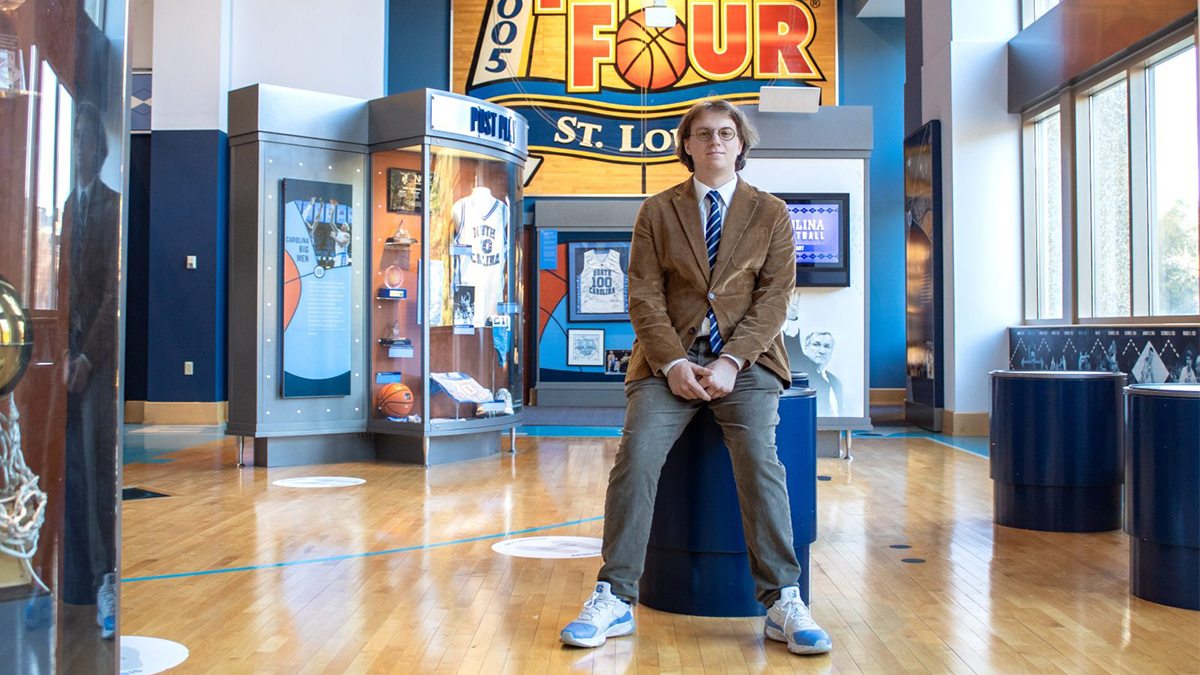Student statistician brings research to game day
Junior Conor Kerr teamed up with Carolina Athletics and statistics scholars to create the Sports Analysis Intelligence Laboratory.

On basketball game days at Carolina, Conor Kerr is always close to the action.
Since Kerr’s first year at UNC-Chapel Hill, the junior from Wilmington has worked with the men’s varsity basketball team as a student statistician, a role he helped to create. The position bridges research and athletics to provide Carolina’s coaching staff and players with pivotal information to help improve performance on and off the court.
He got the idea to pursue sports research with Carolina Athletics before he enrolled, asking the admissions office to connect him with athletics teams who might want to work with an undergraduate statistician.
“I wanted to make an immediate impact on my community,” said Kerr, a double major in statistics and analytics and economics with a mathematics minor in the College of Arts and Sciences.
When someone on the men’s basketball staff gave him a call, that sealed the deal on attending Carolina, he said.
“It started slowly,” Kerr said. Under the supervision of Doug Halverson, head athletic trainer, and the men’s basketball staff, Kerr began working with data from the summer. His first projects focused on scouting or evaluating players’ and the team’s overall strengths and areas of improvement. But player performance soon became his main area of interest.
Halverson and the exercise and sport science and statistics and operations research departments helped Kerr research possible effects of players’ training intensity and load on game day performance. He used metrics from wearable accelerometers — small sensors that collect player data like sprints, jumps and stops in real time as they practice — to analyze the effects of practice time and movement intensity on game outcomes.
Kerr found that the data supported a short, intense practice the day before a game and a longer, less intense practice two days before game day. He presented the findings last spring at the Office for Undergraduate Research’s Celebration of Undergraduate Research. He was able to repeat the research with the women’s varsity basketball team, which he has worked with since the summer before his sophomore year.
In the process, Kerr said he learned much about basketball, sport science and professional life from Halverson and is “incredibly proud to call him a mentor.” Another mentor is Mario Giacomazzo, teaching assistant professor in the statistics and operations research department.
Giacomazzo encouraged the creation of a formal program to expand undergraduate sports analysis opportunities to other Tar Heels. The Sports Analysis Intelligence Laboratory was founded in 2022 and became a formal tie between Carolina statistics and athletics.
In addition to basketball, the SAIL program works with varsity swimming and diving, women’s varsity tennis and the Applied Physiology Laboratory –– including professor Abbie Smith-Ryan and doctoral student Sam Moore –– in exercise and sport science. SAIL has also grown its team: Two more graduate students and a faculty member have joined, and SAIL is accepting applications for more undergraduate sports analysts.
After he graduates in 2025, Kerr plans to pursue a master’s and doctorate in economics and to “lead a life of public service through creative research and make a positive impact on those in my community.”
SAIL, he hopes, can make a similarly positive and long-lasting impact.
“I hope that, as the group continues to grow, it will become something of a staple within UNC, where people from all over the university can come to collaborate on top-notch analytical research in sports.”







